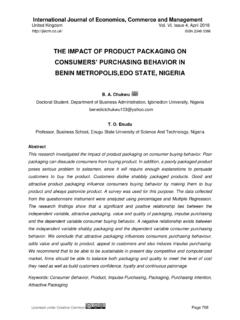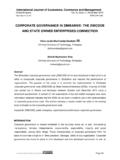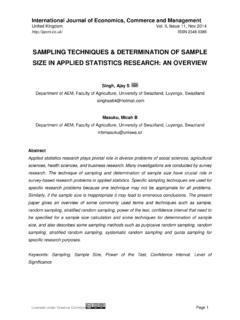Transcription of ASSESSMENT OF FACTORS INFLUENCING AND
1 International Journal of Economics, Commerce and Management United Kingdom Vol. III, Issue 11, November 2015 Licensed under Creative Common Page 127 ISSN 2348 0386 ASSESSMENT OF FACTORS INFLUENCING AND INHIBITING CONTAINERIZED FREIGHT FLOW IN NIGERIAN SHIPPING LOGISTICS Adebambo O. SOMUYIWA Department of Transport Management, Faculty management Sciences Ladoke Akintola University of Technology, Ogbomoso, Oyo State, Nigeria Olusegun O. ADEPOJU Department of Transport Management, Faculty management Sciences Ladoke Akintola University of Technology, Ogbomoso, Oyo State, Nigeria Victor A. DOSUNMU Department of Transport Management, Faculty management Sciences Ladoke Akintola University of Technology, Ogbomoso, Oyo State, Nigeria Abstract The choice of transportation is invariably based on distance, time taken, and cost of reaching each destination by different modes of transport.
2 The distance is also considered from the speed perspective and movement time; while the volume of carriage and flexibility of mode is also important FACTORS in freight flow. However, shipping logistics can be influenced by the port processing speed, number of vehicles (trucks and trailers) at the port, rail and road networks. Shippers tend to assess all aforementioned FACTORS in selection and processes of shipping logistics. Therefore, this paper assessed FACTORS INFLUENCING and inhibiting freight flow in Nigerian shipping logistic with data collected from seven out of eight ICD concessionaires cum logistics companies using multiple regression analysis. Results from the analysis revealed that, number of vehicles loading at seaports and inadequacy of road network are not statistically significant.
3 Timeliness in movement, volume of carriage, flexibility of mode and speed of vehicle Somuyiwa, Adepoju & Dosunmu Licensed under Creative Common Page 128 are considered by shippers in modal choice. Therefore, there is need for revitalization of rail transport and port processing activities to enhance efficient Nigerian shipping logistics freight flow. Keywords: Transport, Rail, Road, Logistics, INFLUENCING , Inhibiting, FACTORS INTRODUCTION The key element in logistics chain is transportation system which joins separate activities together. Transportation occupies one-third of the amount in logistics cost and transportation systems influences the performance of logistics systems greatly NCPDM (1982; Chang, 1988). Historically, Nigerian shipping logistics has been moving materials and products through rail and road logistics can be influenced by the port processing speed, number of vehicles at the port, rail and road networks.
4 Douglas and Howard (1979) described assessing logistics as an effective logistics system that ensures delivery of the right products and services to the right customers at the right time while minimizing cost and rewarding all participants based on value added to the supply chain. The components he said are: storage, transportation, centres, distribution and e-commerce. Shipping logistics is increasingly witnessing applications of series of approach to solve global supply chain and myriads of shipping logistics problems. Ports are particularly affected by ever increasing container volumes as their operational capability becomes highly constrained. Increase in container volumes causes increased pressure on entire logistics network resulting into congestion, high dwell time and higher logistics costs (Japan International Cooperation Agency, 2009; Arvis, 2010; UNCTAD, 2009).
5 In light of these constraints, ports have embarked on implementation of inland container depots (ICDs) as operational and capacity enhancement strategy for easing pressure at congested maritime terminals (Haralambides and Gujar, 2011). Brooks (1984) found that the determinants, which affect the shippers choice of a carrier with reference to Canadian exporters, are cost of service, frequency, reputation and transit time. Whyte (1993) indicated that the decisions of the shippers were relied on the port, delivery time, contract and reliability. Studies revealed that speed and reliability were the most important service FACTORS for shippers, followed by freight rate, loss and damage. The choice of the integrated logistics companies for the firms was shown to depend not only on the sensitivity of industry competition, environment changes, but also on the shipping charges, delivery ability, accuracy, and response ability.
6 Chiu (1996) examined the logistics performance of liner shipping in Taiwan from both shippers and carriers points of view. The results of the study showed that International Journal of Economics, Commerce and Management, United Kingdom Licensed under Creative Common Page 129 the most important service attributes to shippers were prompt response from carrier to any problem, transit time reliability, documentation services, notice of delay, and assistance of loss/damage claims from carrier. Invariably, timely delivery is relative to speed. In speeding however, attention must be given to safety. If consideration is given to speed to achieve timely delivery and consideration is not given to safe- speed, it may result in accident that can reverse the whole logistics objectives.
7 Kaplan and Cooper (1982) and others argued that logistics system should capture all relevant areas in its ASSESSMENT . They described performance evaluation as a way to review organizations both their financial and non-financial objectives. Nigerian roads especially relating to this study linking ports and hinterland sometimes are full of pot holes that are responsible for breakage of vehicles along the major roads resulting to incessant traffic jams, congestion and environmental pollution. The road seems to contribute to often break-down of vehicles even with proper maintenance. However, road transportation charges are more than rail transportation charges (Ubogu, 2011). Cost of fuel accounts for more than 50 percent of the running cost of truck, heavy labour charges engaged for unloading, road traffic congestion because of bad road conditions, loss of time and money contributes to higher transportation charges.
8 The rail is basically a long hauler and slow mover of raw materials (coal, iron ore, etc) and of low-valued manufactured products (food, paper and wood products) and prefers to move shipment sizes of at least a full carload. This mode of transport is most suitable for long distance bulk goods. Rail transport is not flexible and cannot offer door to door services. Furthermore, the cost of putting rail tracks across the places in Nigeria is another major constraint. Rail transport requires special equipment and can encounter sudden delay as a result of problems arising from erosion that might have thwarted the rail tracks. Odeleye (2000) reported that the Nigerian railway network comprises 3,505 kilometers of narrow gauge ( ), single track running parallel through north-west to south-west and from south-east to north-east of the country.
9 It is in the light of these that the paper attempts to analyse and subsequently articulate variables that are likely to challenge the flow of containerized fright in Nigerian shipping logistics with a view to providing possible solutions to these problems through harnessing various potentials that are available for these flow of freight, but that have remained untapped and unexplored. LITERATURE REVIEW The major function of transport system of any country is the efficient delivery of goods in the fastest and cheapest way possible. Nigeria has its coastline on only one side of the quadrangle. It also has deep rich hinterland producing most of the export products and consuming most of Somuyiwa, Adepoju & Dosunmu Licensed under Creative Common Page 130 the import items.
10 The ocean and river ports (developed and potential) are (a) Lagos (Tin Can Island and Apapa), Port Harcourt, Bonny, Calabar, Sapele, Warri, Burukutu,Koko (developed) (b) Oron, Badagry, Epe, Opobo, Eket, Forcados, Akassa, Brass, NunIbeno and Ikang (potential). Prominent and common to all the weak logistics system, deriving from poor infrastructural base, management inertia and incremental but uncoordinated and unimpressive improvement in logistics are directly specific to Nigeria (Ballou, 1998). Although, it is still estimated that some 100,000 tonnes of cargo is still transported along the Bight of Benin where waterways are the only available mode of transportation, the inland share in transport market is statistically insignificant (Botha and Filani, 2006).



















